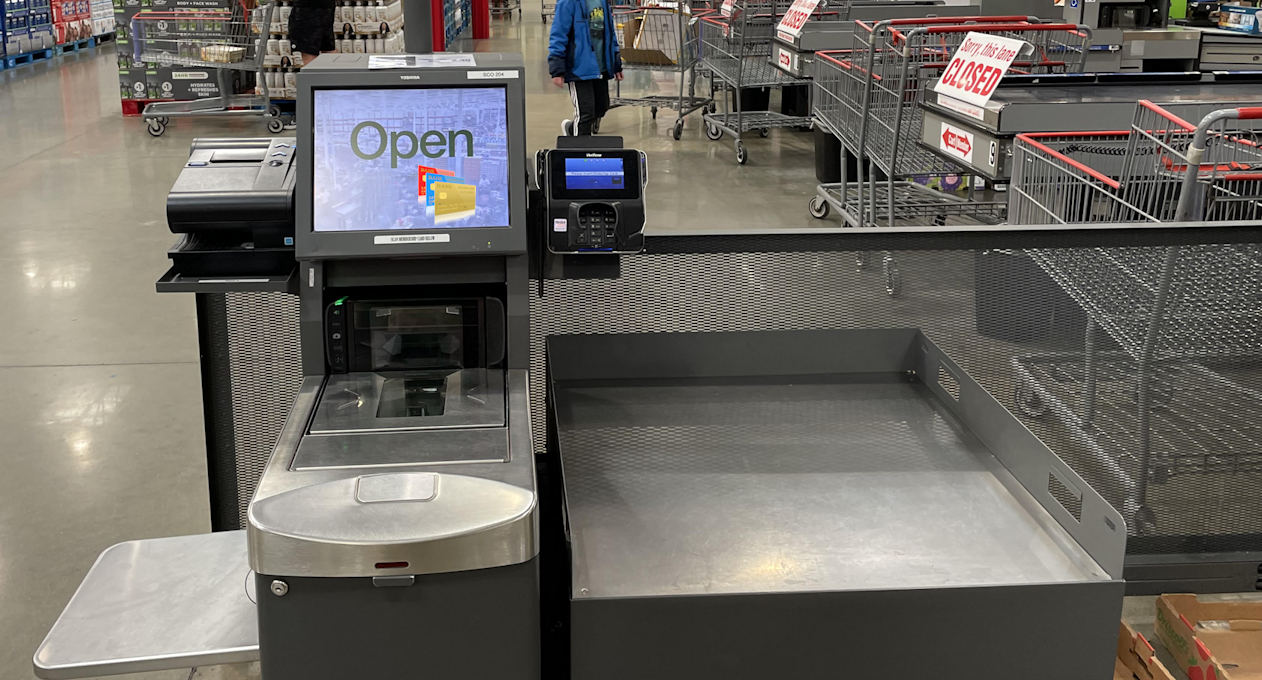Everyone knows that customers dislike long checkout lines. That’s why self-checkout machines were first introduced nearly two score years ago — to reduce long checkout lines. Journalist Amanda Mull explains, “When self-checkout kiosks began to pop up in American grocery stores, the sales pitch to shoppers was impressive: Scan your stuff, plunk it in a bag, and you’re done. Long checkout lines would disappear. Waits would dwindle. Small talk with cashiers would be a thing of the past. Need help? Store associates, freed from the drudgery of scanning barcodes, would be close at hand to answer your questions.”[1] According to Wikipedia, “The machines were originally invented by David R. Humble at Deerfield Beach, Florida-based company CheckRobot Inc., with NCR Corporation having the largest market share. They were introduced to the public in July 1986; the first machine, produced by CheckRobot, was installed in a Kroger store near Atlanta, Georgia.” According to Mull, self-checkout machines haven’t proven to be all that convenient. She explains: “You still have to wait in line. The checkout kiosks bleat and flash when you fail to set a purchase down in the right spot. Scanning those items is sometimes a crapshoot — wave a barcode too vigorously in front of an uncooperative machine, and suddenly you’ve scanned it two or three times. Then you need to locate the usually lone employee charged with supervising all of the finicky kiosks, who will radiate exasperation at you while scanning her ID badge and tapping the kiosk’s touch screen from pure muscle memory.” Lack of convenience, however, is only one of your problems. After all, self-checkout made you an unofficial, unpaid, and untrained store employee. On the other hand, you (and/or less honest customers) are the retailer’s problem. The success of self-checkout machines largely depends on the honesty of customers and that has proved to be a problem. Journalist Chris Gorrie reports, “Walmart’s heavy reliance on self-checkout has necessitated the deployment of workers as makeshift security personnel, actively monitoring customers for potential theft.”[2] Such measures, Gorrie observes, means “honest patrons are disgruntled not only by the additional workload but also by the implicit lack of trust conveyed by the store.” On the other hand, he notes, confronting customers suspected of not scanning items can be uncomfortable for employees. Mull concludes that self-checkout is a failed forty-year experiment. The Extent of the Problem Some people deliberately fail to scan all the items believing they deserve a tip for being an unpaid employee of the retailer. Of course, such thinking is simply justification for theft — and theft is a huge problem. Journalist Catherine Knowles explains, “Retail theft, particularly via self-checkout points, has been increasing drastically over the past year. According to a Retail Threat Curve Report recently released by Everseen, cart-based loss (unscanned items left in the shopping cart at the end of the payment process) now accounts for 30% of all incidents at self checkouts, doubling over the past year. This trend has represented significant financial loss for retailers, with average annual loss from this source alone exceeding $102,000 for a typical grocery store with 12 self-checkout lanes.”[3] All retailers, not just grocers, are suffering from inventory losses. Knowles reports, “The National Retail Federation estimates that retail shrinkage — the discrepancy between advertised inventory and actual stock on hand — represents an approximately $112 billion problem. While efforts to combat shoplifting have led many stores to put products behind glass or in cages, the threat of cart-based loss at the checkout lingers heavily.” Christopher Andrews, an associate professor at Drew University and author of The Overworked Consumer: Self-Checkouts, Supermarkets, and the Do-It-Yourself Economy, asserts, “[Self-checkout] hasn’t delivered anything that it promises. Stores saw this as the next frontier… If they could get the consumer to think that [self-checkout] was a preferable way to shop, then they could cut labor costs. But they’re finding that people need help doing it, or that they’ll steal stuff. They ended up realizing that they’re not saving money, they’re losing money.”[4] Journalist Sam Becker reports that many stores are reconsidering their self-checkout strategy. He explains, “[Self-checkout machines are] not exactly cheap to get into stores: some experts estimate a four-kiosk system can run six figures. Despite the cost to install them, many retailers are reversing course on the tech. Target, for instance, is restricting the number of items self-checkout customers can purchase at one time. Walmart has removed some self-checkout kiosks in certain stores to deter theft. In the UK, supermarket chain Booths has also cut down on the number of self-service kiosks in its stores, as customers say they’re slow and unreliable. Dollar General, one of the fastest-growing retailers in the US, is also re-thinking its strategy. … They are now planning to increase the number of employees in stores ‘and in particular, the checkout area,’ according to the company’s CEO, Todd Vasos.”[5] The Future of Self-checkout Considering all the problems associated with self-checkout, the future of the technology has been questioned. Freelance writer Timothy Sweezy reports, “Brick and mortar stores are finding that self-checkout is not as cost effective as they had hoped it once would be. This has companies rethinking the entire self-checkout process, with some even pulling self-checkout kiosks altogether from stores.”[6] The decision, of course, is all about profitability. Sweezy explains, “Shrinkage can have a devastating effect on a business’s bottom line, and the front office’s bonus checks. Self-checkout provides an easier opportunity for people to steal items, as well as inadvertently miss scanning an item during checkout. One thing remains certain: Companies will continue to look for ways to cushion their bottom line.” Journalist Anne D’Innocenzio agrees that self-checkout has come to a point of self-reckoning. Nevertheless, she predicts, “Self-checkout isn’t going away, especially with still stubborn labor shortages. And plenty of people love it.”[7] Some people might be surprised to learn that a growing number of customers like self-checkout. To prove her point, D’Innocenzio notes, “In 2021, self-checkout usage represented 30% of transactions, almost double from 2018, according to a survey of retailers by FMI, an industry group. And 96% of retailers surveyed offer self-checkout.” Journalist Sommer Stockton reports that more recent survey data underscores that trend. She writes, “Self-checkout continues to gain traction in grocery, with 43 percent of consumers expressing a preference for it over traditional checkout, according to a recent report from NCR Voyix Corp.”[8] Stockton reports younger shoppers prefer self-checkout more than older shoppers. She explains, “A generational snapshot of responses from the survey — which explores how dining, grocery and fuel convenience purchase behaviors are changing among U.S. consumers — indicates that 53 percent of younger shoppers (ages 18 to 44) prefer self-checkout. Of those consumers who do, speed, shorter lines and privacy are the most important factors. Shoppers ages 45 to 60 prefer traditional checkout, but the top reason behind their choice is that they often have many products and may find a regular lane less time consuming.” Concluding Thoughts With younger shoppers showing a preference for self-checkout, I doubt self-checkout kiosks will disappear altogether. Nevertheless, more stringent security measures will continue to be put in place to curtail theft. Grocery sector journalist Jeff Wells agrees self-checkout kiosks are here to stay. He observes, “Self-checkout is an imperfect technology that got rolled out to shoppers quickly in order to paper over retailers’ operational challenges. While many other retail technologies get improved upon through closed-door testing and careful scaling, self-checkout is going through these growing pains in front of hundreds of millions of consumers. Grocers need to recognize the limitations of self-checkout and do as much as they can to offset them. They also need to stay on top of the latest innovations that can help improve the user experience and cut down on shrink.” At the same time, Sweezy believes customers still want a choice when checking out. He concludes, “The bottom line for customers will, hopefully, be a return to being able to choose between using self-checkout kiosks or letting a paid employee do it for them more readily.” As he noted earlier, profitability will be the final determinant. Footnotes[1] Amanda Mull, “Self-Checkout Is a Failed Experiment,” The Atlantic, 18 October 2023.[2] Chris Gorrie, “Walmart Adopts Controversial New Self-Checkout Measures Amidst Shoplifting Concerns,” Savvy Dime, 23 January 2024.[3] Catherine Knowles, “Retail theft at self-checkouts doubles, AI poses possible solution,”…
Self-Checkout Turns Customers into Employees and Employees into Security Guards

Sign Up for Our Newsletters
Get notified of the best deals on our WordPress themes.









